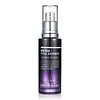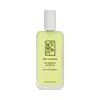What's inside
What's inside
 Key Ingredients
Key Ingredients

 Benefits
Benefits

 Concerns
Concerns

No concerns
 Ingredients Side-by-side
Ingredients Side-by-side

Water
Skin ConditioningButylene Glycol
HumectantLactobacillus/Pumpkin Ferment Extract
Skin ConditioningBifida Ferment Lysate
Skin ConditioningNiacinamide
SmoothingMethyl Gluceth-20
HumectantGlycerin
HumectantPhenoxyethanol
Preservative1,2-Hexanediol
Skin ConditioningSodium Hyaluronate
HumectantCaprylhydroxamic Acid
Aureobasidium Pullulans Ferment
Skin ConditioningAdenosine
Skin ConditioningBoswellia Serrata Resin Extract
SmoothingCamellia Sinensis Leaf Extract
AntimicrobialPanax Ginseng Root Extract
EmollientSodium Polyacrylate
AbsorbentCopper Tripeptide-1
Skin ConditioningEthylhexylglycerin
Skin ConditioningAcetyl Hexapeptide-8
HumectantWater, Butylene Glycol, Lactobacillus/Pumpkin Ferment Extract, Bifida Ferment Lysate, Niacinamide, Methyl Gluceth-20, Glycerin, Phenoxyethanol, 1,2-Hexanediol, Sodium Hyaluronate, Caprylhydroxamic Acid, Aureobasidium Pullulans Ferment, Adenosine, Boswellia Serrata Resin Extract, Camellia Sinensis Leaf Extract, Panax Ginseng Root Extract, Sodium Polyacrylate, Copper Tripeptide-1, Ethylhexylglycerin, Acetyl Hexapeptide-8
Water
Skin ConditioningButylene Glycol
HumectantGlycerin
HumectantPanthenol
Skin Conditioning1,2-Hexanediol
Skin ConditioningPropanediol
SolventSpirulina Maxima Extract
SmoothingLaminaria Japonica Extract
Skin ProtectingBetaine
HumectantLactobacillus/Centella Asiatica Extract Ferment Filtrate
Skin ConditioningXanthan Gum
EmulsifyingAllantoin
Skin ConditioningSodium Phytate
Trehalose
HumectantCitric Acid
BufferingSodium Hyaluronate
HumectantChamaecyparis Obtusa Water
MaskingCentella Asiatica Extract
CleansingPyrus Malus Fruit Extract
Skin ConditioningEthylhexylglycerin
Skin ConditioningGluconolactone
Skin ConditioningSodium Citrate
BufferingSalix Alba Bark Extract
AstringentBeta-Glucan
Skin ConditioningCaprylic/Capric Triglyceride
MaskingHydrogenated Lecithin
EmulsifyingOenothera Biennis Flower Extract
AstringentPinus Palustris Leaf Extract
TonicPueraria Lobata Root Extract
HumectantUlmus Davidiana Root Extract
Skin ConditioningCeramide NP
Skin ConditioningCholesterol
EmollientPolyglutamic Acid
Skin ConditioningAsiaticoside
AntioxidantMadecassoside
AntioxidantAsiatic Acid
Skin ConditioningMadecassic Acid
Skin ConditioningWater, Butylene Glycol, Glycerin, Panthenol, 1,2-Hexanediol, Propanediol, Spirulina Maxima Extract, Laminaria Japonica Extract, Betaine, Lactobacillus/Centella Asiatica Extract Ferment Filtrate, Xanthan Gum, Allantoin, Sodium Phytate, Trehalose, Citric Acid, Sodium Hyaluronate, Chamaecyparis Obtusa Water, Centella Asiatica Extract, Pyrus Malus Fruit Extract, Ethylhexylglycerin, Gluconolactone, Sodium Citrate, Salix Alba Bark Extract, Beta-Glucan, Caprylic/Capric Triglyceride, Hydrogenated Lecithin, Oenothera Biennis Flower Extract, Pinus Palustris Leaf Extract, Pueraria Lobata Root Extract, Ulmus Davidiana Root Extract, Ceramide NP, Cholesterol, Polyglutamic Acid, Asiaticoside, Madecassoside, Asiatic Acid, Madecassic Acid
Ingredients Explained
These ingredients are found in both products.
Ingredients higher up in an ingredient list are typically present in a larger amount.
1,2-Hexanediol is a synthetic liquid and another multi-functional powerhouse.
It is a:
- Humectant, drawing moisture into the skin
- Emollient, helping to soften skin
- Solvent, dispersing and stabilizing formulas
- Preservative booster, enhancing the antimicrobial activity of other preservatives
Butylene Glycol (or BG) is used within cosmetic products for a few different reasons:
Overall, Butylene Glycol is a safe and well-rounded ingredient that works well with other ingredients.
Though this ingredient works well with most skin types, some people with sensitive skin may experience a reaction such as allergic rashes, closed comedones, or itchiness.
Learn more about Butylene GlycolEthylhexylglycerin (we can't pronounce this either) is commonly used as a preservative and skin softener. It is derived from glyceryl.
You might see Ethylhexylglycerin often paired with other preservatives such as phenoxyethanol. Ethylhexylglycerin has been found to increase the effectiveness of these other preservatives.
Glycerin is already naturally found in your skin. It helps moisturize and protect your skin.
A study from 2016 found glycerin to be more effective as a humectant than AHAs and hyaluronic acid.
As a humectant, it helps the skin stay hydrated by pulling moisture to your skin. The low molecular weight of glycerin allows it to pull moisture into the deeper layers of your skin.
Hydrated skin improves your skin barrier; Your skin barrier helps protect against irritants and bacteria.
Glycerin has also been found to have antimicrobial and antiviral properties. Due to these properties, glycerin is often used in wound and burn treatments.
In cosmetics, glycerin is usually derived from plants such as soybean or palm. However, it can also be sourced from animals, such as tallow or animal fat.
This ingredient is organic, colorless, odorless, and non-toxic.
Glycerin is the name for this ingredient in American English. British English uses Glycerol/Glycerine.
Learn more about GlycerinSodium Hyaluronate is hyaluronic acid's salt form. It is commonly derived from the sodium salt of hyaluronic acid.
Like hyaluronic acid, it is great at holding water and acts as a humectant. This makes it a great skin hydrating ingredient.
Sodium Hyaluronate is naturally occurring in our bodies and is mostly found in eye fluid and joints.
These are some other common types of Hyaluronic Acid:
Learn more about Sodium HyaluronateWater. It's the most common cosmetic ingredient of all. You'll usually see it at the top of ingredient lists, meaning that it makes up the largest part of the product.
So why is it so popular? Water most often acts as a solvent - this means that it helps dissolve other ingredients into the formulation.
You'll also recognize water as that liquid we all need to stay alive. If you see this, drink a glass of water. Stay hydrated!
Learn more about Water